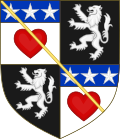William Douglas of Nithsdale
Sir William Douglas of Nithsdale (c. 1370(?) – 1391) was a Scottish knight and Northern Crusader.

Early life
William Douglas was an
A man of apparently dashing bearing, Douglas was with the
A yhowng joly bachelere
Prysyd gretly wes off were,
For he wes evyr traveland
Qwhille be se and qwhille be land
To skathe his fays rycht besy
Swa that thai dred him grettumly— Orygynale Cronykil of Scotland ix, c.21
Marriage
Douglas certainly had gained his spurs by 1387 when he married Egidia Stewart, Princess of Scotland, a daughter of King Robert II and Euphemia Ross. According to the Liber Pluscarden, Egidia Stewart's beauty was well renowned. Charles V of France had "sent a certain most subtle painter to do her portrait and portray her charms, intending to take her to wife." But the King of France and all other of Egidia's admirers had lost out to the chivalric charms of Douglas. Part of her marriage portion were the lands of Nithsdale in south-western Scotland, Herbertshire in the county of Stirling and an annuity of £300.
Ireland
Within his first year of marriage the young Nithsdale led a punitive
Feuding, Crusading and Death
The year after Otterburn a truce was called between Scotland and England. Nithsdale on a knightly quest for glory decided, about 1389, to join the
Issue
By Princess Egidia, Nithsdale had two children:
- Egidia Douglas, known as the "Fair Maid of Nithsdale" married:
- 1. Henry Sinclair, 2nd Earl of Orkney(d. 1422)
- 2. Sir Alasdair Stewart (executed 1425) son of Murdoch Stewart, 2nd Duke of Albany
- 1.
- Sir William Douglas, Knt., Lord of Nithsdale (d.c.1419), knighted when very young as he is described as chevalier in a safe-conduct dated 30 January 1406, when he could not have been more than nineteen.[4]
References
Notes
- ISBN 0-8063-1750-7
- ^ Maxwell v1, pp. 127–8
- ^ Fischer Th. A., The Scots in Eastern and Western Prussia, Edinburgh, 1903, pp. 123–3
- ^ Maxwell, v1, p128
Sources
- Maxwell, Sir Herbert. A History of the House of Douglas, 2 vols, London, 1902.[1]
- Fraser, Sir William. The Douglas Book 4 vols, Edinburgh, 1885.[2]
- Balfour Paul, Sir James. The Scots Peerage 9 vols, Edinburgh, 1906.[3]
- Summerson, Henry. "Clifford, Thomas". doi:10.1093/ref:odnb/5662. (Subscription or UK public library membershiprequired.)
